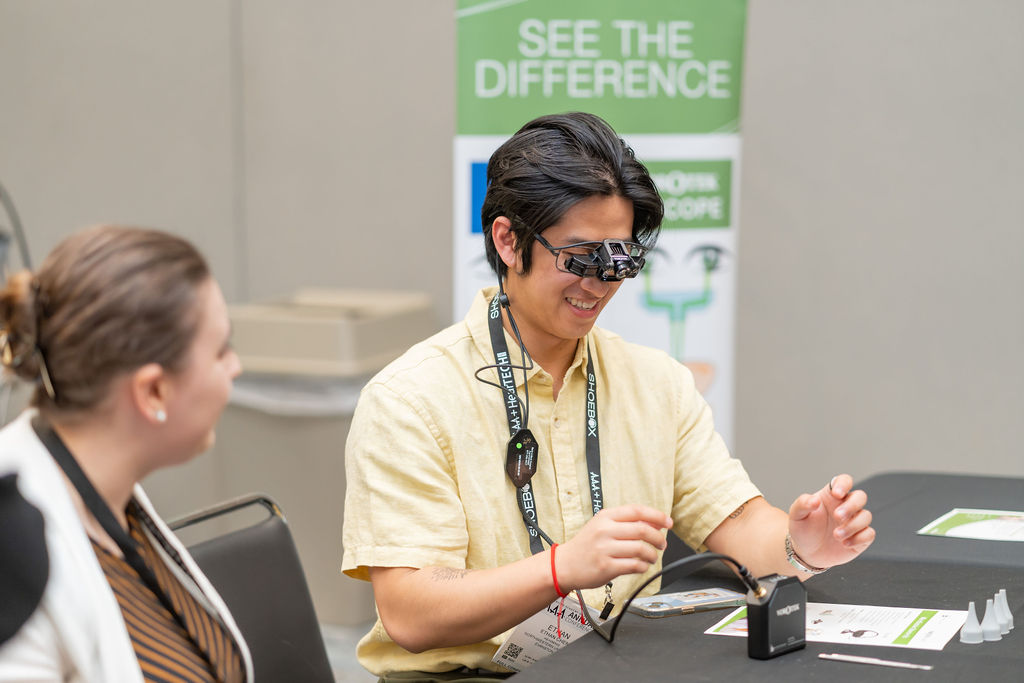Patients with unilateral hearing loss can present with variable issues. Much is dependent on the severity of the hearing loss (threshold and speech understanding), age of onset, hearing status of contralateral ear, and presence of comorbidities (e.g., vertigo, cognitive status, central auditory processing, hyperacusis, tinnitus, disease/pathology/disorder, etc.). Adult-onset severe-to-profound unilateral sensorineural hearing loss with normal hearing sensitivity in the contralateral ear presents a unique dilemma. The most common issues described in this population include difficulty understanding speech-in-noise, sound localization, awareness of sound located on the compromised side (even in quiet), and tinnitus.
Several options exist to address adult-onset severe-profound unilateral sensorineural hearing loss with normal contralateral hearing sensitivity. One approach is traditional amplification. This will be dependent on remaining function in the affected ear and ability to achieve audibility. A second approach is rerouting of the signal to the contralateral normal hearing ear. This may be accomplished by use of a contralateral routing of signal (CROS) hearing aid or through bone conduction. Bone conduction can be achieved in two ways, either a high-powered hearing aid or a bone-anchored hearing device. A third approach is to try to restore binaural hearing with the use of a cochlear implant. The final approach is to do nothing. So what to do?
Recently, Kitterick et al. (2016) performed a systematic review and meta-analysis to determine the nature and quality of evidence for the use of hearing instruments in adults with unilateral severe to profound sensorineural hearing loss. The criteria for study inclusion required the following:
- Hearing pure-tone average threshold ≤30 dBHL in the better hearing ear and >70 dBHL thresholds in the compromised ear
- Evidence of a sensorineural hearing loss
- Use of a hearing instrument
- Use of a hearing instrument and placebo device (or no intervention)
- Speech perception measures and/or other outcomes (e.g., localization)
- Design consistent with a controlled trial or prospective observational study
The quality of the studies was assessed based on the level of evidence, use of randomization, blinding, use of control group, identification, and control of confounds, etc. A total of 778 articles were identified, of which only 30 articles reporting on 27 separate studies met the inclusion criteria. The majority of the studies included were pre- and post-comparisons in which the patient acted as their control. All studies were judged to be of low-moderate quality; the reduced quality was most commonly related to lack of power analysis to determine sample size, the non-matched control group, and lack of control for confounding factors.
Evidence was then described for speech perception in quiet, speech perception in noise, sound lateralization/localization, hearing health-related quality of life and complications/adverse events. In each of these areas, there was a comparison of re-routing vs. unaided, bone-conduction device vs. air-conduction device, cochlear implant vs. unaided, and cochlear implant vs. rerouting. Brief summaries of these findings are provided.
Speech Perception in Quiet
No overall evidence of benefit was indicated with speech presented directly in front of patients in aided vs. unaided performance. One study showed compromised speech perception accuracy in individuals with an air conduction routing device. Also, no overall evidence of benefit was indicated for bone conduction vs. air conduction device for re-routing of the signal. Cochlear implant studies only examined pre and post-perception in the implanted ear only; therefore, no evidence of benefit for improved binaural performance was demonstrated. A condition that seems to be missing in the literature is the presentation of soft speech to the compromised ear in quiet, consistent with someone talking softly on the compromised side.
Speech Perception in Noise
The benefit was indicated when the compromised ear had a more favorable signal-to-noise ratio (SNR). Conversely, deficits were reported when the compromised ear had less favorable SNR. When noise was comparable for both ears, patients performed better with a bone-conduction device compared to air-conduction re-routing. A similar dependency on SNR was reported with cochlear implant studies. Overall, the evidence suggests benefit and detriment depending on SNR at each ear.
Sound Lateralization/Localization
No overall evidence was indicated for sound lateralization/localization. Some studies reported no effect, some improvement, and others deficits.
Hearing Health-Related Quality of Life
Overall, evidence suggested perceived benefit on hearing health and reduced listening difficulty for re-routing signal. However, limited evidence exists for the quality of life or hearing health for application of cochlear implants to unilateral loss. Also, there was no description of the control for general inclusion/placebo effect.
The most common complaints of individuals with individuals with an adult-onset severe-to-profound sensorineural hearing loss with normal contralateral hearing function include difficulty with speech in noise and localization/lateralization. Overall, the evidence suggests benefit under specific noise conditions and detriment in other noise conditions. Also, no evidence is proposed for localization. Despite limited evidence for common complaints, in general, patients report perceived benefit. This may be in particular in situations with minimal background noise, and the speaker of interest is positioned on their compromised side. However, this situation, or condition, was either not reported or discussed in the studies reviewed. Furthermore, there was a minimal discussion of fatigue and listening effort during signal rerouting, where now the patient needs to deal with bilateral input with one functioning side. Finally, none of these studies report on having the patient simply turn their head.
Reference
Kitterick PT, Smith SN, Lucas L (2016). Hearing Instruments for Unilateral Severe-Profound Sensorineural Hearing Loss in Adults: A Systematic Review and Meta-Analysis, Ear and Hearing 37(5):495–507.
Recent Posts
Turn Insight Into Action! Attend Learning Labs at AAA 2026
Ready to take your professional development to the next level? At AAA 2026, Learning Labs are your chance to go beyond lectures and dive into…
Your Support Makes the Difference—Let’s Finish the Year Strong
As we wrap up the year, I want to thank you for your generosity supporting the AAA Foundation’s work. The enclosed report highlights what you…
Audiology Faces New Challenges Under Draft Federal Loan Rule: What Comes Next
Member Action Needed Soon! The U.S. Department of Education’s Advisory Committee has reached consensus on proposed regulations implementing the higher education provisions of the One…


